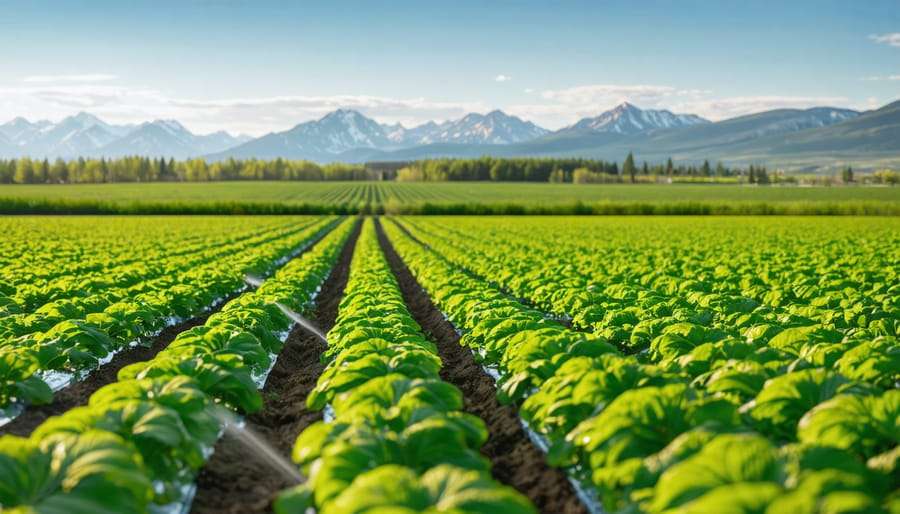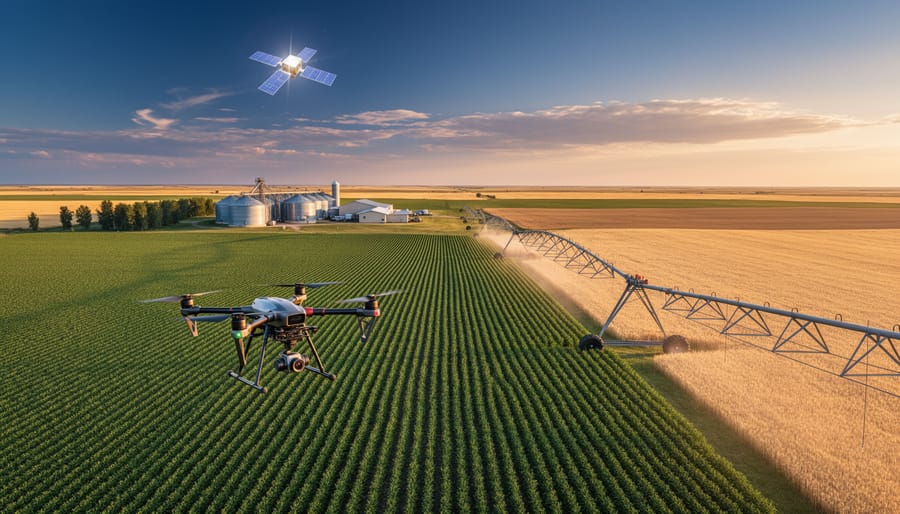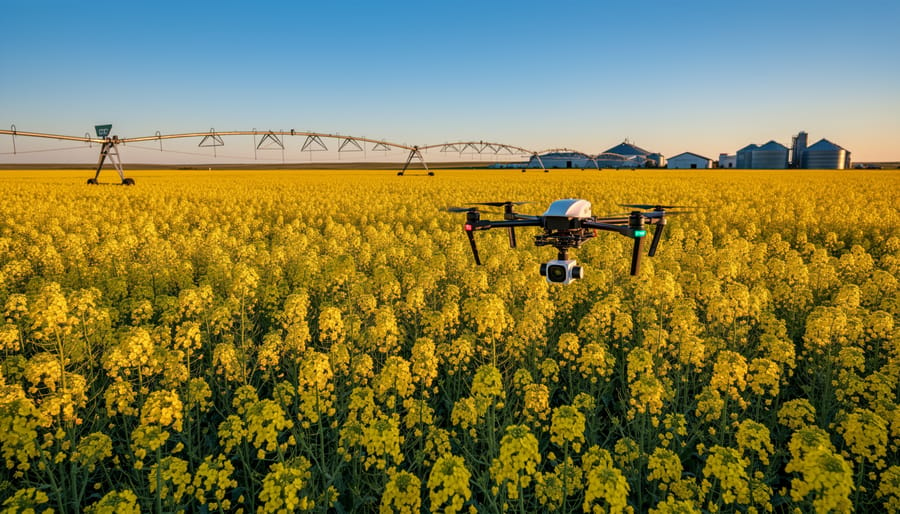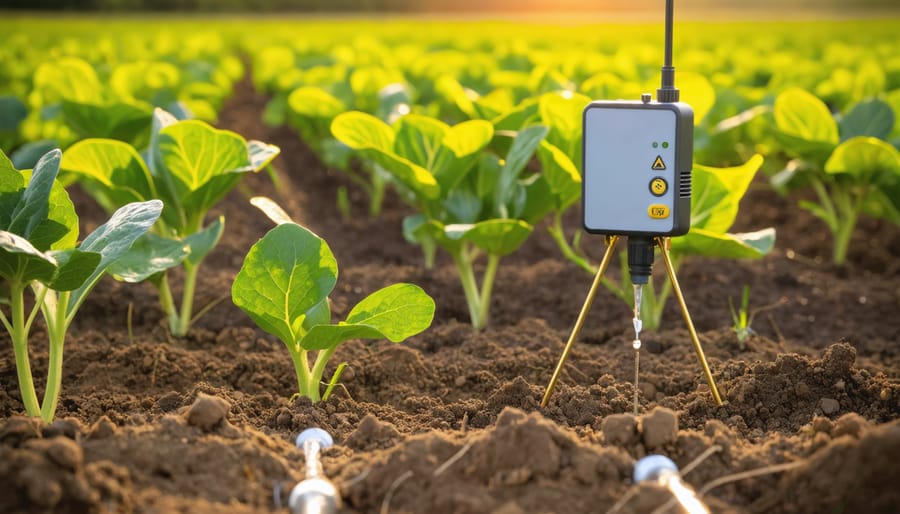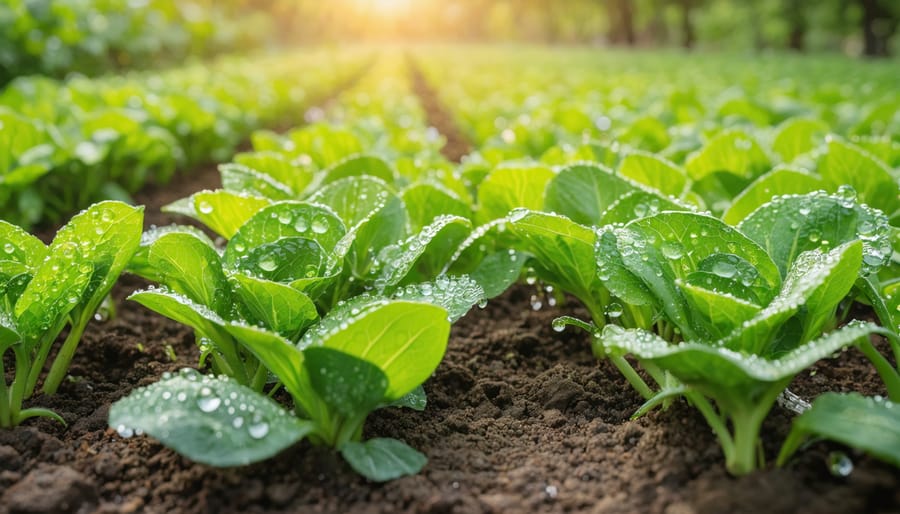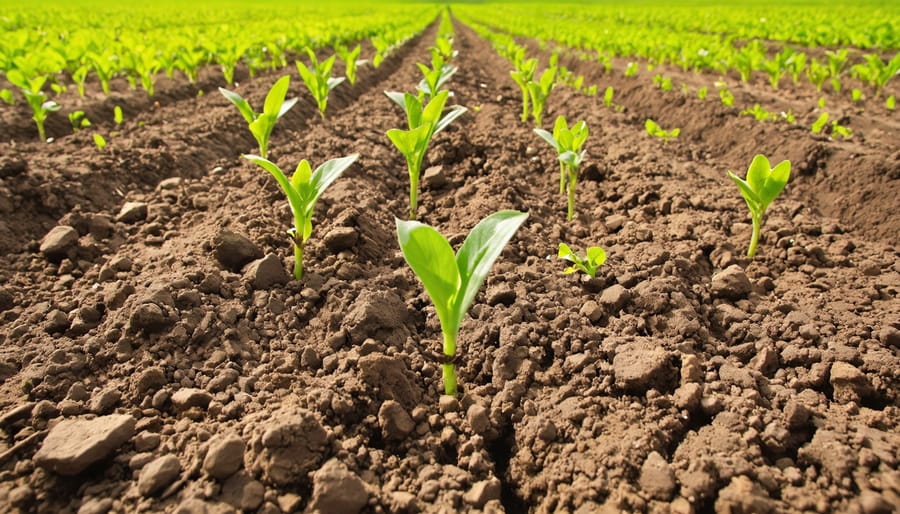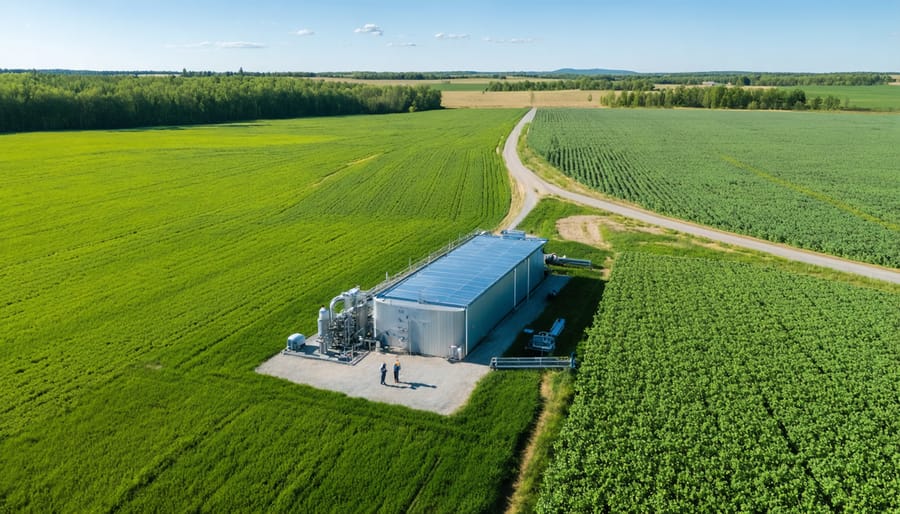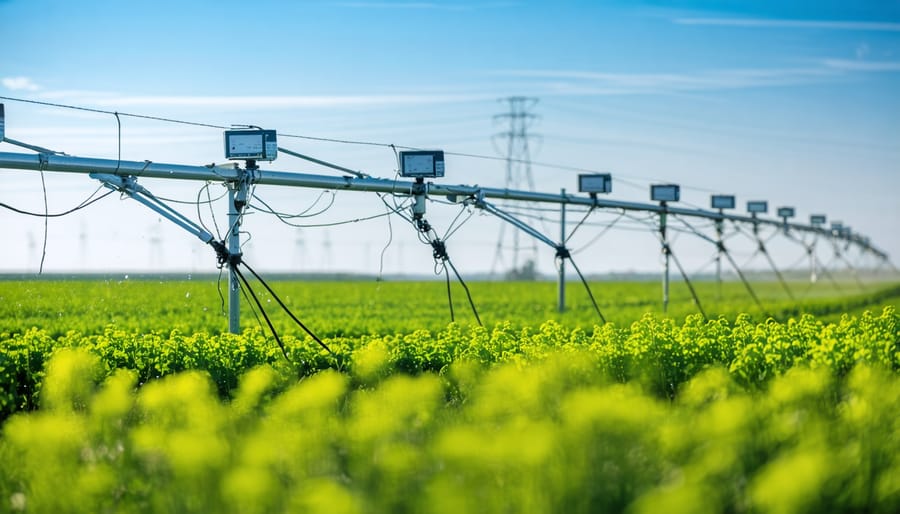Implement precision irrigation scheduling to cut water waste and fuel consumption by up to 30% while maintaining optimal soil moisture levels. Monitor soil organic carbon through regular testing and adjust irrigation patterns based on real-time moisture sensors, creating a data-driven approach to reducing carbon emissions through water management. Install water-efficient drip systems and low-pressure sprinklers that decrease pumping energy requirements while improving water distribution uniformity across fields. Integrate cover crops and organic mulches into your rotation to enhance soil water retention, reducing irrigation frequency and associated carbon outputs by 15-25% annually. These practical solutions, proven effective across Alberta’s diverse agricultural regions, demonstrate how smart water management directly impacts both farm productivity and environmental stewardship. By adopting these strategies, local farmers have documented significant reductions in energy costs while maintaining or improving crop yields, creating a sustainable model for future generations.
Water’s Hidden Carbon Cost in Organic Agriculture
Energy Use in Irrigation
Irrigation practices significantly impact your farm’s carbon footprint through energy consumption. In Alberta, where water management is crucial, choosing the right irrigation method can lead to substantial energy savings. Traditional pivot systems typically consume between 20-30 kilowatt-hours per hectare daily during peak season, while modern precision irrigation systems can reduce this by up to 30%.
Drip irrigation systems, though initially more expensive, use approximately 40% less energy compared to conventional sprinkler systems. Many Alberta farmers have found success with solar-powered drip systems, which virtually eliminate operational energy costs. For example, the Turner Valley Organic Farm reduced their irrigation-related energy consumption by 65% after switching to a solar-powered drip system.
Gravity-fed irrigation, where possible, offers the most energy-efficient solution. However, when pumping is necessary, variable frequency drives (VFDs) can optimize energy use by adjusting pump speeds based on actual water needs. Regular system maintenance, including checking for leaks and ensuring proper pressure settings, can prevent unnecessary energy waste. Consider conducting an energy audit of your irrigation system – many local agricultural extension offices offer this service at reduced rates.
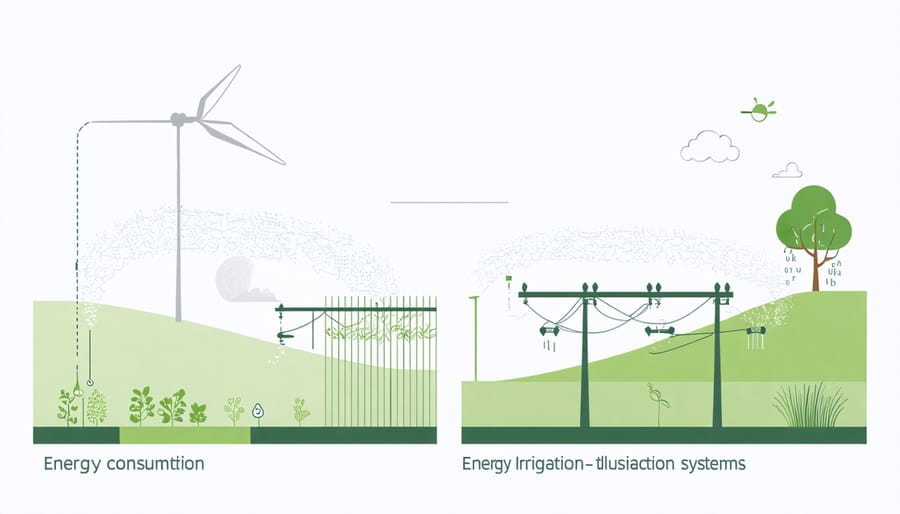
Treatment and Pumping Emissions
Water treatment and distribution systems on farms contribute significantly to our carbon footprint, but there are ways to make these processes more efficient. The energy required to pump, treat, and distribute water across farm operations can account for up to 30% of a farm’s total energy consumption.
In Alberta, many farmers have found success by implementing variable frequency drives (VFDs) on their pumping systems, which can reduce energy usage by 20-40%. These smart systems adjust pump speeds based on actual demand, preventing unnecessary energy consumption during low-usage periods.
Water treatment processes also impact carbon emissions. Traditional chemical treatments often have a high carbon footprint due to manufacturing and transportation. Many Alberta farmers are switching to natural filtration methods, such as constructed wetlands and bio-filters, which not only reduce carbon emissions but also improve water quality naturally.
Regular maintenance of pumping systems is crucial. A well-maintained pump operates more efficiently and uses less energy. Simple actions like checking for leaks, cleaning filters, and ensuring proper pressure levels can significantly reduce the carbon impact of your water management system.
Carbon-Smart Water Solutions for Alberta Farms
Low-Energy Irrigation Systems
Implementing modern irrigation technologies that minimize energy consumption is a key strategy for reducing your farm’s carbon footprint. Low-pressure systems, such as drip irrigation and micro-sprinklers, can decrease pumping requirements by up to 50% compared to traditional high-pressure systems.
Here in Alberta, many farmers have found success with gravity-fed irrigation systems that utilize natural elevation changes across their land. These systems require minimal to no electrical power, relying instead on topographical advantages to distribute water efficiently.
Solar-powered pumps are gaining popularity among organic farmers, particularly for smaller operations. These systems can be especially effective when combined with soil moisture sensors and automated controls, allowing for precise water delivery only when needed.
Time-of-use irrigation scheduling is another effective approach. By operating systems during off-peak hours, typically overnight, farmers can take advantage of cooler temperatures when evaporation rates are lower. This not only reduces energy consumption but also improves water use efficiency.
For those considering upgrades, the Canadian Agricultural Partnership offers cost-share funding for energy-efficient irrigation equipment. Local irrigation districts can provide guidance on system selection and implementation based on your specific field conditions and crop requirements.
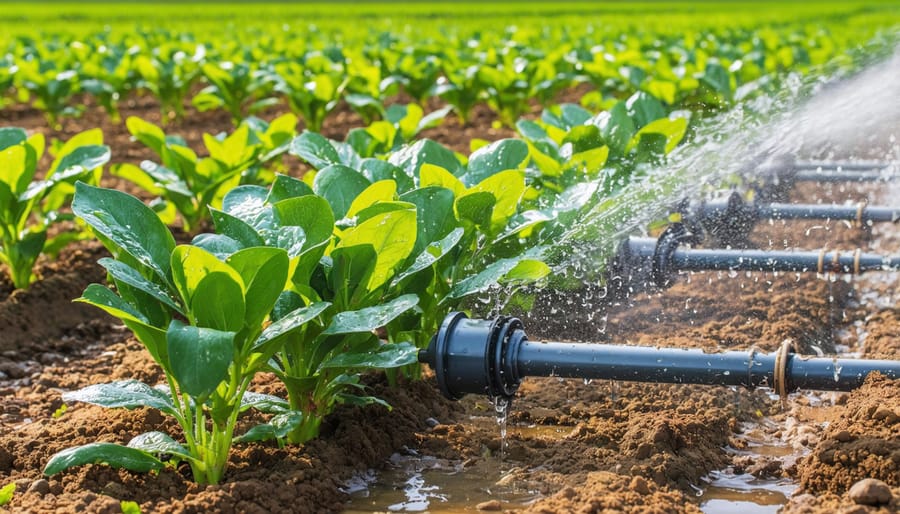
Soil Moisture Management
Effective soil moisture management plays a crucial role in carbon sequestration and overall soil health. Alberta farmers have been successfully implementing various soil moisture retention techniques that work hand-in-hand with carbon management strategies.
Incorporating organic matter through cover crops and crop residues helps create a sponge-like soil structure that holds water more effectively. Many Red Deer County farmers have reported up to 30% improvement in water retention by maintaining at least 30% crop residue coverage on their fields.
Reduced tillage practices are particularly effective in our prairie climate, as they minimize soil disturbance and maintain natural soil structure. This approach has helped farmers in Lacombe and surrounding areas reduce water evaporation by up to 25% during dry spells.
Using mulch and maintaining continuous living cover protects the soil surface, reducing evaporation while adding organic matter. Local success stories show that farmers using these methods have maintained optimal soil moisture levels even during periods of reduced rainfall.
Consider implementing these practices gradually, starting with test plots to observe what works best for your specific soil conditions. Remember that maintaining proper soil moisture not only supports carbon sequestration but also improves overall crop resilience and yield potential.
Water Recycling Methods
Water recycling on organic farms isn’t just about conservation – it’s a smart investment that helps manage carbon emissions while protecting our precious water resources. Here in Alberta, where water availability can be unpredictable, implementing efficient recycling systems has become increasingly important for sustainable farm operations.
A popular approach among local farmers is the installation of rainwater harvesting systems, which can collect up to 600 litres of water for every millimetre of rainfall per 100 square metres of roof area. These systems typically include storage tanks, filtration units, and distribution networks that can significantly reduce groundwater usage.
Grey water recycling systems are another effective solution, allowing farmers to reuse water from washing facilities and equipment cleaning for irrigation. Sarah Thompson, an organic farmer near Red Deer, reports saving approximately 40% on water consumption after implementing a grey water system on her 160-hectare farm.
For greenhouse operations, closed-loop irrigation systems have proven particularly effective. These systems capture, filter, and reuse irrigation water, reducing water consumption by up to 70% while maintaining optimal growing conditions. The Miller Family Farm in Lacombe demonstrates this success, having cut their water usage in half while maintaining their organic certification.
Treatment options like constructed wetlands and bio-filtration systems not only clean water for reuse but also create valuable wildlife habitat and enhance biodiversity on the farm. These natural solutions align perfectly with organic farming principles while contributing to carbon sequestration through increased plant growth.
Real Results: Alberta Farm Case Studies
Southern Alberta Success Story
The Henderson family farm in Lethbridge County stands as a shining example of how strategic water management can significantly reduce carbon emissions while maintaining profitable operations. In 2019, Mike and Sarah Henderson implemented an innovative water conservation program that yielded remarkable results within just two years.
By installing soil moisture sensors across their 2,000-hectare farm and adopting precision irrigation techniques, the Hendersons reduced their water usage by 40% compared to their previous practices. This reduction in water pumping and distribution led to a 30% decrease in their overall carbon emissions, primarily through reduced energy consumption.
“We were surprised to see how much energy we were wasting by over-irrigating certain areas,” shares Mike Henderson. “The soil sensors helped us deliver exactly what each section needed, when it needed it.”
The Hendersons also introduced drought-resistant crop varieties and adjusted their irrigation scheduling based on real-time weather data. Their water management strategy included collecting rainfall in retention ponds and implementing drip irrigation systems in areas previously served by pivot sprinklers.
The project required an initial investment of $75,000, but the farm recovered these costs within 18 months through reduced energy bills and improved crop yields. The Hendersons now save approximately $40,000 annually in operational costs while maintaining the same production levels.
Their success has inspired neighboring farms to adopt similar practices, creating a ripple effect of positive environmental impact throughout Southern Alberta.
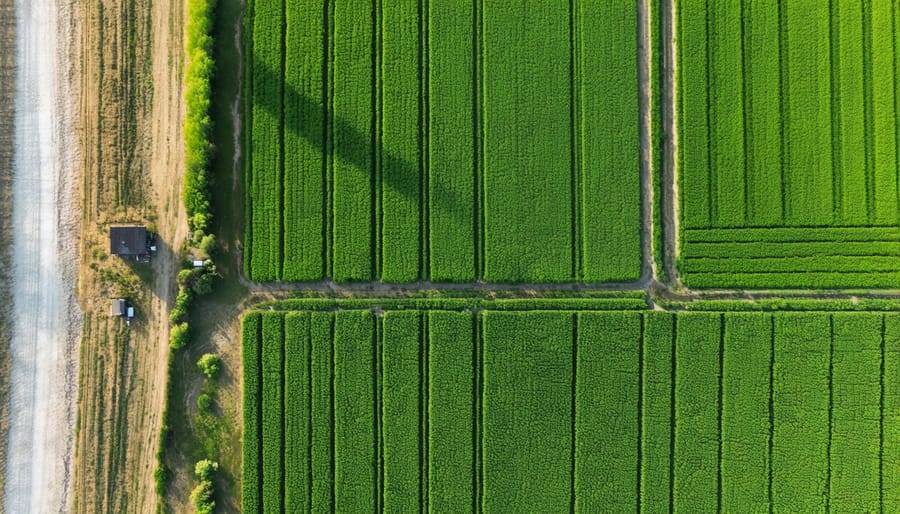
Central Alberta Innovation
The Wheatland County Farm Collective has emerged as a pioneering force in sustainable water management, showcasing how innovation can transform agricultural practices in Central Alberta. In 2022, five family farms collaborated to implement a shared water recycling system that has reduced their collective water consumption by 40%.
The system, developed in partnership with local agricultural engineers, captures and filters water from various farm operations, including greenhouse condensation and livestock facilities. This recycled water is then redistributed through a network of smart irrigation systems that monitor soil moisture levels in real-time.
Sarah Johnson, one of the participating farmers, reports that the initiative has not only decreased their environmental impact but also resulted in significant cost savings. “We’ve cut our water bills by almost half, and our crops are thriving with the precisely managed irrigation schedule,” she explains.
The project’s success has inspired neighboring communities, with three more farming collectives in Red Deer County now developing similar systems. The implementation required an initial investment of $75,000, but through government grants and shared costs among participants, each farm’s contribution was manageable.
The collective also established a knowledge-sharing program, hosting monthly workshops where they demonstrate their water recycling techniques to other farmers in the region. This community-driven approach has created a ripple effect of sustainable practices across Central Alberta’s agricultural landscape.
Implementation Guide and Resources
Getting Started Steps
Begin your carbon management journey by conducting a thorough assessment of your current farming practices. Take stock of your water usage patterns, irrigation systems, and soil moisture levels across your fields. This baseline information will help you measure progress and identify key areas for improvement.
Next, connect with your local agricultural extension office or the Alberta Agriculture and Forestry department. These organizations offer valuable resources and can help you access funding programs specifically designed for sustainable farming initiatives. Many Alberta farmers have found success by participating in workshops and training sessions offered through these channels.
Start small by implementing changes in a test plot. Consider installing soil moisture sensors and weather monitoring equipment to gather data on water consumption patterns. This approach allows you to fine-tune your methods before scaling up across your entire operation.
Create a detailed implementation timeline that accounts for seasonal changes and crop rotation schedules. Include regular monitoring points to track progress and adjust your strategy as needed. Remember that successful carbon management is an ongoing process that requires patience and flexibility.
Build relationships with neighbouring farmers who have experience with sustainable practices. The Alberta farming community is known for its collaborative spirit, and many experienced farmers are willing to share their knowledge and lessons learned. Their practical insights can help you avoid common pitfalls and accelerate your progress toward effective carbon management.
Finally, document everything. Keep detailed records of your water usage, soil conditions, and any changes you implement. This information will be invaluable for future planning and can help you qualify for environmental stewardship programs.
Alberta Support Programs
Alberta farmers can access numerous available support programs to help implement carbon management practices on their farms. The Environmental Farm Plan (EFP) offers funding of up to $50,000 per project for initiatives that reduce greenhouse gas emissions and improve soil health. Through the Canadian Agricultural Partnership (CAP), farmers can receive technical assistance and financial support for implementing practices like cover cropping and reduced tillage.
The Agriculture Financial Services Corporation (AFSC) provides specialized loans for environmental improvements, including carbon management infrastructure and equipment. Local agricultural fieldmen and extension specialists offer free consultations to help farmers develop personalized carbon management strategies.
The Irrigation Efficiency Program supports producers with up to 40% of costs for upgrading to water-efficient systems that reduce energy consumption and carbon emissions. Additionally, the Farm Energy and Agri-Processing Program helps offset the costs of energy-efficient equipment and renewable energy installations.
Through the Results Driven Agriculture Research (RDAR) initiative, farmers can participate in research projects and receive compensation for testing innovative carbon management practices. The Growing Forward 2 program continues to support knowledge transfer and demonstration projects, connecting farmers with successful adopters of carbon-smart practices in their region.
Carbon management on Alberta farms isn’t just about environmental stewardship – it’s about building a more resilient and profitable agricultural future. By implementing the practices we’ve discussed, from soil conservation to efficient water management, you’re taking meaningful steps toward reducing your farm’s carbon footprint while potentially accessing carbon credit opportunities.
Remember, every farm is unique, and there’s no one-size-fits-all approach. Start with practices that make the most sense for your operation, and gradually expand your carbon management strategy. Take advantage of local resources, connect with agricultural extension services, and learn from fellow farmers who have successfully implemented these practices.
Your efforts in carbon management contribute to both Alberta’s agricultural sustainability goals and Canada’s broader climate commitments. Together, we can build a stronger, more sustainable farming community while preserving our land for future generations.

